ACROPOLIS • AKPOΠOΛIΣ
THE WORD :
VISITING :
WHY? :
THE PROJECT :
LINKS
- the word
- acro - polis [a`kropolis]
- greek: AKPO = edge + ΠOΛIΣ = city
- Literally the top of the city.
- Usually, in ancient and mediaeval times a defensive castle including temples and important buildlings would be built at the top of a city’s highest hill.
e.g. the acropolis of Mycenae, the acropolis of Nauplion. By 'acropolis' only, we always mean the Athens Acropolis.
|
Acropolis rock,
Lycabettus hill behind it
and Herodion Odeon in front of it.
ENLARGE
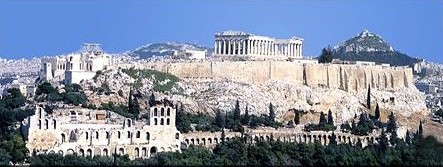
|
visiting the Acropolis
Make sure you are not visiting during the hottest hours of the day.
Check the opening-closing timetable.
Make sure they are not on strike!
Don't forget the Acropolis Museum too.
You may reach the entrance in two ways:
1. The boring way: MÉTRO station: ACROPOLIS and walk up to your left.
2. The exciting way (you may be lost): stroll in the picturesque old neighbourhood of Plaka. Find your way up the hill to Peripatos (the narrow path that leads to the Acropolis). Peripatos means 'stroll'. In fact, you have to climb up hill. I love it.
After visiting there:
...go down the other side of the hill to the Philopappou hill just opposite and take a nice coffee at the Lombardiaris little church-yard, designed by the architect Pikionis. From here, you have the best view of the Parthenon.
|
lost?

surrounding the Acropolis area:
the magical pavements
by Pikionis
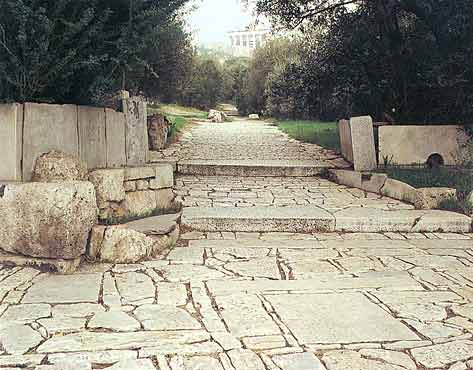
|
Why the Parthenon?
Why is it so much more important than other temples of graeco-roman art? Obviously, for symbolic reasons. Here, young girls and boys were sculpted on its frieze alongside with gods. Here, the statue of goddess Athena (only copies survive), huge though it was, has never cast a heavy shadow on the citizens.
Artistically, it is said to be the apogee of temple architecture, not to mention its sculpted decorations. At school we are given an endless list of its proportions, measurements etc. and most Acropolis guides are full of them. But here is the bottom line: If you have seen lots and lots of temples, you will realise that the Parthenon does NOT give the impression of a box-like shape. When you gaze at it from far away, it seems ready to fly, so light and alive!
|
the Parthenon
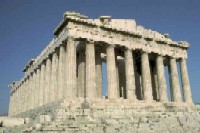
|
For an athenian of today, the Acropolis is not just an ancient monument:
It is the scene of historical drama during the 1820s.
It is the romantic rock where fatal lovers ended their lives during the 1830s...
|
L'Acropole
a shepherd and his sheep
by the swiss photographer
Frédéric Boissonnas (1858-1946)
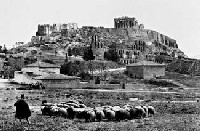
|
It is the triumphant symbol of resistance once more: during the german occupation two young boys, Glezos and Siantos climbed in the night's darkness and...
|
World War II
the Parthenon
during nazi occupation
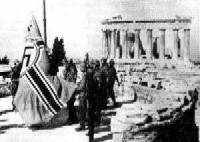
|
It is still alive as an active symbol...
|
protesting against war
15 Feb 2003
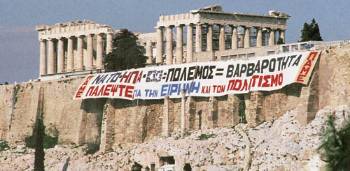
|
...more to come: Stories about the Acropolis, that you do not know...
|

|
- ↑
- PROJECT: ACROPOLIS (AKPOΠOΛIΣ) BUILDINGS: 447 a.e.v.
- Proposal by: Pericles (ΠEPIKΛHΣ), head of state, leader of democratic party of the city-state of Athenae (AΘHNAI)
- Ratification by: the majority of the Demos of Athenians (ΔHMOΣ AΘHNAIΩN)
- Funded by: the city of Athens and the Delian League (the athenian alliance) treasuries.
- I don't think the allies were happy with the tremendously high budget!!
- Supervisor: Phidias (ΦEIΔIAΣ)
- Architects: Phidias (ΦEIΔIAΣ), Ictinus (IKTINOΣ) and Callicrates (KAΛΛIKPATHΣ), Mnesicles (MNHΣIKΛHΣ)
- Other art-craftsmen: unknown artist/craftsmen (the ancient greek word is the same for both: TEXNITAI-technitae) from Athens, Paros island and other places.
- Buildings: Parthenon (temple to Athena Parthenos = virgin), Erekhthion, Athena Nike = victory, Pinakotheke = gallery, Propylaea = entrance.
- Technical support: the marble quarry of Attica Mountain Pentelikon (ΠENTEΛIKON) mainly.
- COMPLETED in: 432 a.e.v, additions till 330 a.e.v.
- in following centuries:
- Byzantine period: Parthenon turned into a church.
- Ottoman occupation: Parthenon turned into a mosque. Parthenon turned into a powder-gun storage room: explosion during siege by Morosini. After several attempts, Elgin manages to buy and take off a lot of the Parthenon marble decorations. He transfers them to Great Britain.
- Modern period: Restorations and removal of all additions.
- Contemporary period: The Athens air pollution severely damaged the surface of marbles. Now, air pollution is being monitored. Earthquakes are also a problem. The Acropolis buildings are under a continuous Acropolis Restoration Programme.
- Return of the Parthenon Marbles from Britain to the Parthenon: .../.../200... (to be updated)
- THE PRINCIPLES:
- 1. All aesthetic creatures that are World Heritage must live within their destined, natural environment.
- 2. They belong to humanity (UNESCO or whatever organization of that sort exists in the future).
- 3. The curators, are the people that happen to live at the particular place at any time.
- 4. Museums' purpose: to present their own place's authentic items, as well as authorized replicas of international World Heritage items. The colonial-era occidental museums (presenting items that were collected in previous centuries from foreign places) are a thing of the past.
- ↑
- Links on Acropolis
- My favourite photos of the rock.
- Acropolis rock photographed with sheppards and sheep in the previous century by Fred Boissonnas. Page by www.fotoart.gr
- Acropolis through the eyes of Grisel Gonzalez at her www.grisel.net Interesting photos with helpful captions. No boring details.
- https://earthobservatory.nasa.gov/IOTD/view.php?id=3065&eocn=image&eoci=related_image
- http://www.greeklandscapes.com/images/destinations/acropolis/other_photos/lma002030102_acropolis_aerial.jpg 323 kb
- photos at CrysTal
- Acropolis UNESCO
- Acropolis and other archaeological sites at odysseus.culture.gr
- Acropolis by wikipedia and its Museum
- Matt's Acropolis Guide
-
- Perseus Architecture Athens, Parthenon
- Acropolis Restoration Programme
- Columbia.edu Parthenon Frieze
- The British Committee for the Restitution of the Parthenon Marbles
- The stones of Parthenon - From Pentelicon to the Parthenon
- Books in english and greek (Melissa Pub.) by Manolis Korres, the architect that has worked for so many years on the Sacred Rock! He gives us a sensitive narration and illustrations about a piece of marble of the old acropolis, the artists and craftsmen.
- Athens City Guide - What you need to know about Acropolis charts map of the builidings
- The Athenian Acropolis by Livio C. Stecchini
links checked in Aug 2007, Oct 2017.






